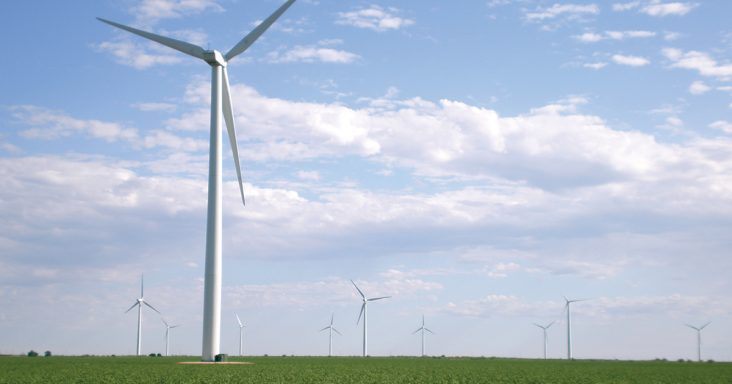SWEPCO to spend $1.01 billion to add 810 megawatts of wind energy
by February 25, 2020 10:43 am 2,008 views

A proposal in front of regulatory bodies in three states would allow electricity utility Southwestern Electric Power Co. (SWEPCO) to purchase more than half of the wind energy from three wind farms in north central Oklahoma.
If approved, SWEPCO would spend $1.01 billion to acquire 54.5% of the 1,485-megawatt combined generating power of the three facilities, collectively known as the North Central Wind Energy project, which is being developed by Invenergy. The first wind farm would be completed by the end of 2020, and the other two would be completed by the end of 2021. The wind generating facilities would provide 810 megawatts of clean energy to SWEPCO customers in Arkansas, Louisiana and Texas, said Peter Main, spokesman for SWEPCO.
The facilities are projected to save SWEPCO customers about $2 billion over the facilities’ expected 30-year life span, Main said. The savings will be passed on to customers primarily through fuel costs as the wind generating facilities don’t have fuel costs like coal-fired or natural gas-fired plants. Over the same period, the savings attributed to SWEPCO customers in Arkansas would be $413 million. The state’s share of the proposed project would be 155 megawatts.
“It will help further diversify SWEPCO’s energy resource mix,” he said. “And it also helps make our communities more attractive for economic development.”
SWEPCO will jointly own the wind farms with electricity utility Public Service Co. of Oklahoma, which will acquire 45.5% of the project. Both are companies of Columbus, Ohio-based utility American Electric Power. Currently, SWEPCO purchases 469 megawatts of wind energy from facilities in Kansas, Oklahoma and Texas, but this would be the first wind facility owned by SWEPCO. Wind energy accounts for a 9% share of the utility’s electricity generating mix, and after this project is completed, it would account for 21%, Main said. Within 20 years, SWEPCO’s clean energy goals show that one-third of its electricity generating mix will comprise renewable sources.
After the wind farms begin operating, customers can expect energy savings to start in 2021, and the savings will rise as the additional wind farms come online. Customers will start to see the full benefits of the wind farms in 2022 after they are all operating. The project also will allow customers to purchase renewable energy credits to meet their renewable energy or sustainability goals, Main said. He noted that Walmart, Tyson Foods, the University of Arkansas and the city of Fayetteville have such goals.
BROAD SUPPORT
In January 2018, the city of Fayetteville became the first city in the state to commit to transition to 100% clean and renewable sources of energy when Fayetteville City Council approved the city’s Energy Action Plan. It shows the city would be powered by 100% clean energy by 2050, and all government operations would be powered with 100% clean energy by 2030. The city government operations are being powered by 72% clean energy. Overall, the city is about 10% powered by renewable energy.
Peter Nierengarten, environmental director for Fayetteville, said SWEPCO’s proposed wind project would have a greater impact on the city overall as about two-thirds of the city receives its electricity from the utility. Ozarks Electric Cooperative provides one-third of the city’s electricity. The share is flipped for city government operations, with SWEPCO providing about one-third of the electricity and Ozarks Electric powering two-thirds.
The city supports SWEPCO’s wind energy proposal, and Mayor Lioneld Jordan on Jan. 2 provided a supporting statement for the project as a public comment with the proposal in front of the Arkansas Public Service Commission.
“Development of this wind project and the broader strategy set forth by SWEPCO align with the goals of the city of Fayetteville to include more clean energy supply for its residents,” Jordan wrote. “The economic benefit of stable low-cost electricity to the city of Fayetteville is an important factor in the city’s long-term planning. Locked-in rates allow the city to refine budgetary projections and finance capital projects at lower interest rates. As a result, consistently stable electricity prices have an impact across city operations and community infrastructure.”
Katie Niebaum, executive director of Arkansas Advanced Energy Association, said the project looks to deliver low-cost energy and economic benefits to Arkansas while helping companies and universities to meet their renewable energy goals. She noted that Arkansas voters want their political leaders to develop policies to encourage technologies like energy efficiency and increase access to renewable energy sources.
“Advanced energy technologies provide jobs and energy savings in states that deploy them,” Niebaum said. “By enhancing access to these resources like this wind project, the industry can continue to be an economic driver for Arkansas.”
Glen Hooks, director of the Arkansas Chapter of the Sierra Club, said the environmental group supports the project. Not only would this project reduce rates for Arkansas ratepayers, he said, it also would improve air quality in the state if it leads to retirements of coal-fired plants. His only concern for the project would be if it didn’t lead to more retirements. He noted three aging coal-fired plants in Northwest Arkansas and Texas should be considered for retirement.
“This is a really good opportunity for them to put those dirty plants on a path to retirement as they are bringing more clean energy into their portfolio,” Hooks said. “They’ve been, I think, a little more resistant than some other utilities to closing down some of their coal plants. This is a great opportunity for them to do that as they’re bringing clean energy online.”
Recently, SWEPCO agreed to seek approval to retire the 650-megawatt coal-fired Dolet Hills Power Plant near Mansfield, La., by the end of 2026. This was part of a settlement agreement approved by the Arkansas Public Service Commission in December.
UNANIMOUS AGREEMENT
On Jan. 24, SWEPCO filed a settlement agreement with unanimous support from the Arkansas Public Service Commission general staff, the office of Arkansas Attorney General Leslie Rutledge and Walmart Inc. on SWEPCO’s proposal to acquire the three wind farms in north central Oklahoma.
SWEPCO initially filed the proposal seeking commission approval on July 15, 2019, and it’s the largest wind energy project requesting commission approval since the 2,000-megawatt Wind Catcher project, said Donna Gray, executive director of the Arkansas Public Service Commission. Those in the settlement agreement filed documents supporting the project and have requested that the commission decide on the project by May 8.

A hearing is set for March 10 in front of the commission, but that might not be needed. Those in the settlement agreement are seeking commission approval on how SWEPCO plans to recover the costs of the project. Initial briefs on this were scheduled for noon Feb. 18, and reply briefs are set for noon Tuesday (Feb. 25). The commission is expected to rule on the briefs once they are filed and could vote to cancel the hearing.
Main said a rider has been proposed to help pay for the project, and the reduction in fuel costs as a result of the project is expected to more than offset the rider. He noted that regulatory approval is needed for construction to be completed as expected, allowing SWEPCO to receive $750 million in production tax credits and offsetting the $1.01 billion project cost. If completed as planned, the first wind farm would receive 100% of the federal tax credits, and the other two would receive 80%. The U.S. production tax credit provides operators with a tax credit per kilowatt-hour of renewable electricity generation for the first 10 years a facility is in operation, according to the U.S. Energy Information Administration (EIA).
SWEPCO also is seeking regulatory approval in Texas and Louisiana. The hope is those states reach a decision on the project by late spring, Main said. If a state were to decide against the project, another state could benefit by receiving more megawatts of the project. For example, if Texas didn’t approve the project, Arkansas would be allocated 268 megawatts of the project’s capacity. Or, if Louisiana didn’t approve the project, Arkansas would be allocated 245 megawatts.
Wind capacity in the United States is projected to rise to 122 gigawatts by the end of 2020, according to the EIA. As of the third quarter of 2019, Texas had the most capacity installed, at 26.9 gigawatts, followed by Iowa, Oklahoma and Kansas. These four states account for half of the total wind capacity installed in the United States.
Arkansas had no utility-scale wind capacity, as of the third quarter of 2019, according to the EIA. However, it has 160.69 megawatts of solar generating capacity, according to the Solar Energy Industries Association (SEIA). In 2018, Arkansas added the 18th most solar projects among the 50 states when it installed 118 megawatts of solar generation, according to a report from the SEIA and GMT Research.
